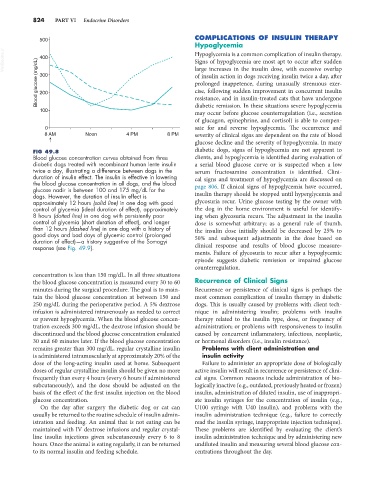Page 852 - Small Animal Internal Medicine, 6th Edition
P. 852
824 PART VI Endocrine Disorders
500 COMPLICATIONS OF INSULIN THERAPY
Hypoglycemia
VetBooks.ir 400 Hypoglycemia is a common complication of insulin therapy.
Signs of hypoglycemia are most apt to occur after sudden
Blood glucose (mg/dL) 300 of insulin action in dogs receiving insulin twice a day, after
large increases in the insulin dose, with excessive overlap
prolonged inappetence, during unusually strenuous exer-
cise, following sudden improvement in concurrent insulin
200
diabetic remission. In these situations severe hypoglycemia
100 resistance, and in insulin-treated cats that have undergone
may occur before glucose counterregulation (i.e., secretion
of glucagon, epinephrine, and cortisol) is able to compen-
0 sate for and reverse hypoglycemia. The occurrence and
8 AM Noon 4 PM 8 PM severity of clinical signs are dependent on the rate of blood
glucose decline and the severity of hypoglycemia. In many
FIG 49.8 diabetic dogs, signs of hypoglycemia are not apparent to
Blood glucose concentration curves obtained from three clients, and hypoglycemia is identified during evaluation of
diabetic dogs treated with recombinant human lente insulin a serial blood glucose curve or is suspected when a low
twice a day, illustrating a difference between dogs in the serum fructosamine concentration is identified. Clini-
duration of insulin effect. The insulin is effective in lowering cal signs and treatment of hypoglycemia are discussed on
the blood glucose concentration in all dogs, and the blood page 806. If clinical signs of hypoglycemia have occurred,
glucose nadir is between 100 and 175 mg/dL for the
dogs. However, the duration of insulin effect is insulin therapy should be stopped until hyperglycemia and
approximately 12 hours (solid line) in one dog with good glycosuria recur. Urine glucose testing by the owner with
control of glycemia (ideal duration of effect), approximately the dog in the home environment is useful for identify-
8 hours (dotted line) in one dog with persistently poor ing when glycosuria recurs. The adjustment in the insulin
control of glycemia (short duration of effect), and longer dose is somewhat arbitrary; as a general rule of thumb,
than 12 hours (dashed line) in one dog with a history of the insulin dose initially should be decreased by 25% to
good days and bad days of glycemic control (prolonged 50% and subsequent adjustments in the dose based on
duration of effect)—a history suggestive of the Somogyi
response (see Fig. 49.9). clinical response and results of blood glucose measure-
ments. Failure of glycosuria to recur after a hypoglycemic
episode suggests diabetic remission or impaired glucose
counterregulation.
concentration is less than 150 mg/dL. In all three situations
the blood glucose concentration is measured every 30 to 60 Recurrence of Clinical Signs
minutes during the surgical procedure. The goal is to main- Recurrence or persistence of clinical signs is perhaps the
tain the blood glucose concentration at between 150 and most common complication of insulin therapy in diabetic
250 mg/dL during the perioperative period. A 5% dextrose dogs. This is usually caused by problems with client tech-
infusion is administered intravenously as needed to correct nique in administering insulin; problems with insulin
or prevent hypoglycemia. When the blood glucose concen- therapy related to the insulin type, dose, or frequency of
tration exceeds 300 mg/dL, the dextrose infusion should be administration; or problems with responsiveness to insulin
discontinued and the blood glucose concentration evaluated caused by concurrent inflammatory, infectious, neoplastic,
30 and 60 minutes later. If the blood glucose concentration or hormonal disorders (i.e., insulin resistance).
remains greater than 300 mg/dL, regular crystalline insulin Problems with client administration and
is administered intramuscularly at approximately 20% of the insulin activity
dose of the long-acting insulin used at home. Subsequent Failure to administer an appropriate dose of biologically
doses of regular crystalline insulin should be given no more active insulin will result in recurrence or persistence of clini-
frequently than every 4 hours (every 6 hours if administered cal signs. Common reasons include administration of bio-
subcutaneously), and the dose should be adjusted on the logically inactive (e.g., outdated, previously heated or frozen)
basis of the effect of the first insulin injection on the blood insulin, administration of diluted insulin, use of inappropri-
glucose concentration. ate insulin syringes for the concentration of insulin (e.g.,
On the day after surgery the diabetic dog or cat can U100 syringe with U40 insulin), and problems with the
usually be returned to the routine schedule of insulin admin- insulin administration technique (e.g., failure to correctly
istration and feeding. An animal that is not eating can be read the insulin syringe, inappropriate injection technique).
maintained with IV dextrose infusions and regular crystal- These problems are identified by evaluating the client’s
line insulin injections given subcutaneously every 6 to 8 insulin administration technique and by administering new
hours. Once the animal is eating regularly, it can be returned undiluted insulin and measuring several blood glucose con-
to its normal insulin and feeding schedule. centrations throughout the day.

